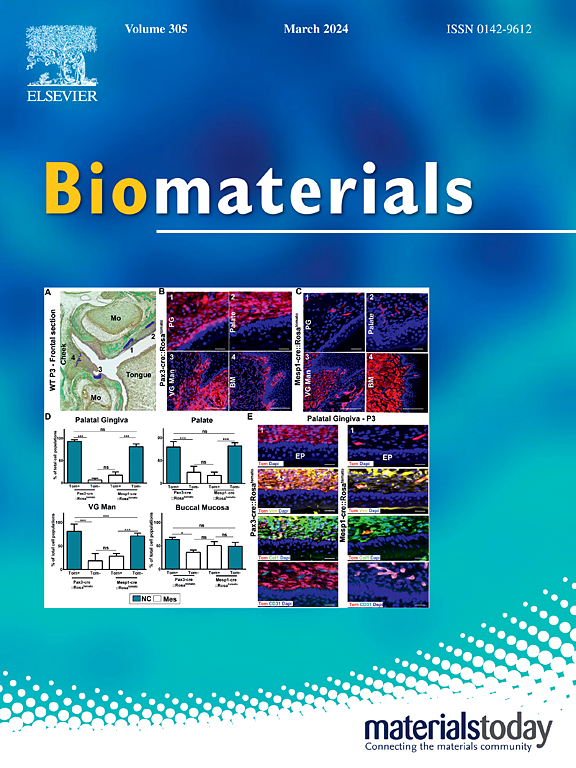A remotely controlled nanotherapeutic with immunomodulatory property for MRSA-induced bone infection
IF 12.8
1区 医学
Q1 ENGINEERING, BIOMEDICAL
引用次数: 0
Abstract
Osteomyelitis is a deep bone tissue infection caused by pathogenic microorganisms, with the primary pathogen being methicillin-resistant Staphylococcus aureus (MRSA). Due to the tendency of the infection site to form biofilms that shield drugs and immune cells to kill bacteria, combined with the severe local inflammatory response causing bone tissue destruction, the treatment of osteomyelitis poses a significant challenge. Herein, we developed a remotely controlled nanotherapeutic (TLBA) with immunomodulatory to treat MRSA-induced osteomyelitis. TLBA, combined with baicalin and gold nanorods, is positively charged to actively target and penetrate biofilms. Near-infrared light (808 nm) triggers spatiotemporal, controllable drug release, while bacteria are eliminated through synergistic interaction of non-antibiotic drugs and photothermal therapy, enhancing bactericidal efficiency and minimizing drug resistance. TLBA eliminated nearly 100 % of planktonic bacteria and dispersed 90 % of biofilms under NIR light stimulation. In MRSA-induced osteomyelitis rat models, laser irradiation raised the infection site temperature to 50 °C, effectively eradicating bacteria, promoting M2 macrophage transformation, inhibiting bone inflammation, curbing bone destruction, and fostering bone tissue repair. In summary, TLBA proposes a more comprehensive treatment strategy for the two characteristic pathological changes of bacterial infection and bone tissue damage in osteomyelitis.

具有mrsa诱导骨感染免疫调节特性的远程控制纳米治疗剂
骨髓炎是一种由病原微生物引起的深部骨组织感染,主要病原体为耐甲氧西林金黄色葡萄球菌(MRSA)。由于感染部位容易形成生物膜,屏蔽药物和免疫细胞杀死细菌,再加上严重的局部炎症反应导致骨组织破坏,骨髓炎的治疗提出了重大挑战。在此,我们开发了一种带有免疫调节剂的远程控制纳米疗法(TLBA)来治疗mrsa诱导的骨髓炎。TLBA与黄芩苷和金纳米棒结合,带正电荷,能主动靶向和穿透生物膜。近红外光(808 nm)触发药物时空可控释放,非抗生素药物与光热疗法协同作用杀灭细菌,提高杀菌效率,减少耐药性。在近红外光刺激下,TLBA消除了近100%的浮游细菌,分散了90%的生物膜。在mrsa诱导的骨髓炎大鼠模型中,激光照射将感染部位温度升高至50℃,可有效根除细菌,促进M2巨噬细胞转化,抑制骨炎症,抑制骨破坏,促进骨组织修复。综上所述,TLBA对于骨髓炎细菌感染和骨组织损伤这两种特征性病理改变提出了更全面的治疗策略。
本文章由计算机程序翻译,如有差异,请以英文原文为准。
求助全文
约1分钟内获得全文
求助全文
来源期刊

Biomaterials
工程技术-材料科学:生物材料
CiteScore
26.00
自引率
2.90%
发文量
565
审稿时长
46 days
期刊介绍:
Biomaterials is an international journal covering the science and clinical application of biomaterials. A biomaterial is now defined as a substance that has been engineered to take a form which, alone or as part of a complex system, is used to direct, by control of interactions with components of living systems, the course of any therapeutic or diagnostic procedure. It is the aim of the journal to provide a peer-reviewed forum for the publication of original papers and authoritative review and opinion papers dealing with the most important issues facing the use of biomaterials in clinical practice. The scope of the journal covers the wide range of physical, biological and chemical sciences that underpin the design of biomaterials and the clinical disciplines in which they are used. These sciences include polymer synthesis and characterization, drug and gene vector design, the biology of the host response, immunology and toxicology and self assembly at the nanoscale. Clinical applications include the therapies of medical technology and regenerative medicine in all clinical disciplines, and diagnostic systems that reply on innovative contrast and sensing agents. The journal is relevant to areas such as cancer diagnosis and therapy, implantable devices, drug delivery systems, gene vectors, bionanotechnology and tissue engineering.
 求助内容:
求助内容: 应助结果提醒方式:
应助结果提醒方式:


